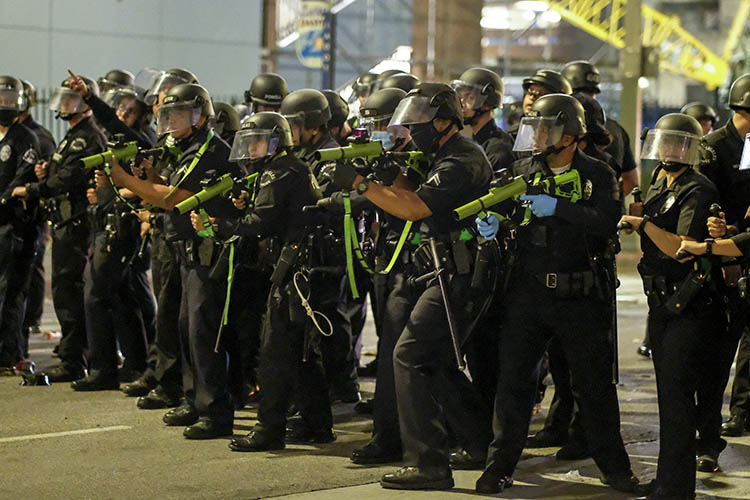After Floyd’s killing, KIPs at protests led to 100-plus head injuries

Police officers prepare to fire rubber bullets during a protest in Los Angeles over the death of George Floyd, a black man killed in police custody on May 25 in Minneapolis. (AP photo by Ringo H.W. Chiu)
“Shot in the Head,” a new report led by UC Berkeley researcher, adjunct professor and Oakland emergency room doctor Rohini Haar, details the life-threatening injuries that can occur when law enforcement officers deploy kinetic impact projectiles (KIPs) — crowd-control weapons classified as “less lethal” that range from rubber and plastic bullets to bean bag, sponge and pellet rounds.
For two months following the May 25 killing of George Floyd in police custody in Minneapolis, Haar put together this interactive report, along with research consultant Scott Reynhout and colleagues at Physicians for Human Rights (PHR), using open-source methods to collect publicly available data on the scope of the use of KIPs across the U.S. and the resulting injuries.
“We were surprised at the violence and how spread out it was in the U.S. — not just in one place, not just in red or blue states, not just in small or large cities. It was really nationwide,” said Haar, a research fellow at Berkeley Law’s Human Rights Center and an adjunct professor at the School of Public Health who studies the health impact of crowd-control weapons.
A previous Physicians for Human Rights review of KIP use by law enforcement in 2017 turned up 310 eye injuries and 100 injuries nationwide in a year’s time, she said, but in just two months in 2020, “we found more than 100 injuries, and it was dismaying.” At least 115 people were shot in the neck or head between May 26 and July 27 of this year at protests immediately following Floyd’s death.
However, the number of people who suffered those injuries is considered to be just a fraction of the actual number of people shot at Black Lives Matter demonstrations across the U.S., the report says, since the PHR’s database only includes incidents documented in traditional and social media.
According to the United Nations Guidance on Less Lethal Weapons in Law Enforcement, known risks of KIPs include skull fractures, brain injuries, permanent blindness, damage to vital organs and death.
The report calls for localities to ban the use of KIPs in crowd-control situations and, in other situations, to use them only as a last resort and to make sure they are used in a way that meets international standard tests “of necessity, proportionality, legality and proper use, i.e., by properly trained police.”
The role of the police, the report emphasizes, should be “to facilitate freedom of assembly and freedom of expression, while ensuring public safety. … Excessive and indiscriminate police responses to protests not only violate the rights of current peaceful protesters, but have a well-studied chilling effect on the future exercise of the fundamental rights to freedom of assembly and expression.”
The PHR report zeroes in on three cities — Los Angeles, Portland and Austin — where the largest number of injuries from KIPs took place. Quotes and graphic images from victims’ social media accounts help tell the stories of injured journalists, protesters and bystanders.
At a march in Los Angeles, for example, C.J. Montano described holding his hands up when he was shot by officers positioned on the roof of a synagogue. His injury exposed his skull; he suffered a traumatic brain injury and bleeding in the brain. He now takes anti-seizure medication and temporarily uses a cane to walk.
According to the report, no evidence has been presented that any of the civilians injured by KIPs were behaving in a manner that warranted the use of lethal force, defined by the LAPD as when someone is violently resisting arrest or poses an immediate threat of violence or physical harm.
While police misconduct cases related to the protests are under investigation, and some officers have been reassigned to non-field duties, the “incidents and injuries identified in this open-source review demand national action on regulation, education and training on the use of force and accountability around all impact projectiles,” the report says.
“We hope people understand the health and the human rights consequences of the continued use of KIPs in protests,” said Haar. “There really is no role for these weapons in crowd-control policing. I already see movement in city councils across the country. But we need state- and federal-level leadership to have a consistent, successful movement to stop KIPs use in protests in this country.”
tinyurlis.gdu.nuclck.ruulvis.netshrtco.de
